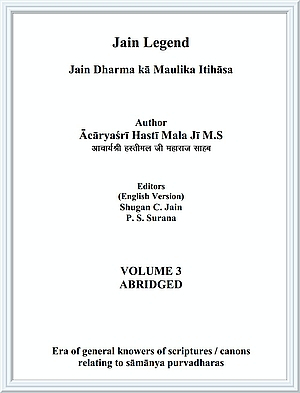(V.N. 1531-1647)
In 972 AD, due to the defeat of 20th ruler of Rāṣṭrakūṭa dynasty King Karka Rāja by Cālukya Rāja Taila and the fall of the seat of Rāṣṭrakūṭa dynasty Mānyakheṭa (Mālakḍheda), Jainism was devoid of royal patronage for some time. During that period, followers of Śaiva and Vaiṣṇava religions with royal patronage of some rulers started a series of many sided cruel blows to Jainism and its followers. As a result, the popular and strong religion of south i.e. Jainism slowly and slowly started becoming feeble and weak.
How to revive and rejuvenate the downslide of Jainism became a constant source of worry and discussion amongst the followers and ācāryas of Jainism. After extended discussions, they all came to conclusion that the only way to stop this downslide of Jainism and regain its original glory, it is essential to seek royal patronage for Jainism from some strong and powerful rulers.
During the period of these discussions, a serious Jainācārya Sudatta, with strong determination to let Jainism out of this rut by gaining royal patronage of a dedicated Jain strong ruler, was in deep meditation and contemplations in Vikaṭa forest habitat Aṃdagai. At that time a young man of Yādava clan arrived at that place of meditation of Sudatta. After paying obeisance and veneration to Ācārya Sudatta he sat in front of him. On being asked by Ācārya, he identified himself as 'Sala'. The ācārya deep in his heart felt that this young man has all the prerequisites which he was looking for in the saviour of Jainism. With these thoughts, he went in deep contemplations on Padmāvatī and that kṣatriya young man continued gazing at the ācārya, sitting in front of the ācārya. After a few moments, that place resonated with the loud roar of a lion. On completion of his meditation, the ācārya opened his eyes and saw a giant lion gushing towards both him and the young man. Seeing the fearless and firm young kṣatriya prince in front of him, addressing the young man, Ācārya Sudatta ordered in the language of that prince ' poya sala' i.e. O Sala, kill it.
Obeying with highest regards the order of his teacher, prince Sala killed in one stroke, the lion galloping towards Ācārya Sudatta.
Seeing the superb valour and bravery of the young Sala, the happiness of ācārya had no bounds. He developed firm belief that this young man is the fittest person to protect and propagate Jainism and Jain congregation after becoming the king and installing a Pro-Jain dynasty. Immediately after this incidence, Ācārya Sudatta started addressing this young and brave Yādava man as Poyasala. Therefore this Yādava dynasty later on became popular Poyasala (and later Hoyasala) dynasty.
With the active support and help of Ācārya Sudatta and Jain congregation, Poyasala, after the defeat and fall of Cālukya dynasty, established Hoysala Empire in the southern part of Cālukya's territory in around 1004AD.
With the royal patronage and support of Hoyasala Empire, Jain religion and congregation started growing with twice the speed. Both Hoyasala dynasty and Jain congregation thinking other's progress and prosperity as their; started jointly working together from the beginning till the end of Hoysala dynasty for making each other prosper and be stronger; rulers of Hoyasala dynasty undertook many exemplary actions to ensure spread of Jainism Alongwith its influence as well as to protect the Jain congregation from all types of calamities and problems.
Names and periods of King Sala and other rulers of Hoyasala dynasty in chronological order are as follows:
- Sala (Poyasala): founder and first ruler of Hoyasala dynasty from 1004-1022 AD.
- Vinayāditya-1; No definite information is available about him.
- Nrapakāma; ruler of Hoyasala dynasty from 1022-1047AD.
- Vinayādītīya-II; third ruler of Hoyasala dynasty from 10471063AD.
- Ereyaṃga; fourth ruler of Hoyasala dynasty from 1063 1100AD.
- Vallāla-I; fifth ruler of Hoyasala dynasty from 1100-1110AD.
- Viṣṇuvardhana; He became the ruler of the dynasty in 1110AD. He Alongwith his chief queen Śāntala Devī, 8 chiefs of armed forces namely Gaṃga Rāja, Boppa, Puṇisa, Baldeva Gaṇa, Mariyā, Bharata, Eca and Viṣṇu, and all sections of his subjects, made unique and exemplary contributions for all round progress, promoting the influence, popularity of Jainism and taking Jainism to the highest levels of popularity.
 Acharya Hasti Mala
Acharya Hasti Mala
